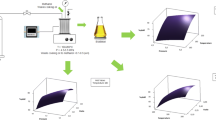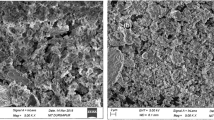Abstract
Biodiesel is a highly potential energy source with the characteristics of renewability and environmental friendliness. In this study, methyl oleate (MO, unsaturated fatty acid) was selected as a model compound for biodiesel. The thermal conversion behavior of MO and the reaction characteristics of copper slag (CS) catalytic pyrolysis of MO were investigated. The thermal conversion behavior of MO was explored by Py-GC/MS and TG-FTIR. The results showed that the pyrolysis products of MO mainly consisted of oxygenated compounds, alkenes, alkanes, and aromatics. Furthermore, the final product of the catalytic pyrolysis of MO by CS was analyzed. More gas products were produced under the effect of CS. The components of the gas products were determined by gas chromatography (GC). The results revealed that CS promoted the production of H2 and CO. The coke was analyzed and characterized by FTIR, Raman and SEM. The addition of CS enhanced the decomposition of oxygen-containing structures, leading to the change of particle size and chemical structure of coke. The research contributes to understanding the thermal conversion behavior of unsaturated fatty acids and the reaction characteristics under the effect of CS. This provides valuable information for the application of biodiesel to replace fossil energy in the copper smelting process.
Graphical Abstract













Similar content being viewed by others
References
Faizan M, Song H (2023) Critical review on catalytic biomass gasification: state-of-art progress, technical challenges, and perspectives in future development. J Clean Prod 408:137224. https://doi.org/10.1016/j.jclepro.2023.137224
Li S, Wu Y, Dao MU, Dragoi E, Xia C (2023) Spotlighting of the role of catalysis for biomass conversion to green fuels towards a sustainable environment: latest innovation avenues, insights, challenges, and future perspectives. Chemosphere 318:137954. https://doi.org/10.1016/j.chemosphere.2023.137954
Ghosh N, Rhithuparna D, Rokhum SL, Halder G (2023) Ethical issues pertaining to sustainable biodiesel synthesis over trans/esterification process. Sustain Chem Pharm 33:101123. https://doi.org/10.1016/j.scp.2023.101123
Kumar A, Singh VP, Srivastava A (2022) Quality biodiesel via biotransesterification from inedible renewable sources. J Clean Prod 379:134653. https://doi.org/10.1016/j.jclepro.2022.134653
Jin X, Li S, Ye H et al (2023) Investigation and optimization of biodiesel production based on multiple machine learning technologies. Fuel 348:128546. https://doi.org/10.1016/j.fuel.2023.128546
Ambat I, Srivastava V, Sillanpää M (2018) Recent advancement in biodiesel production methodologies using various feedstock: a review. Renew Sust Energ Rev 90:356–369. https://doi.org/10.1016/j.rser.2018.03.069
Singh D, Sharma D, Soni SL et al (2021) A comprehensive review of physicochemical properties, production process, performance and emissions characteristics of 2nd generation biodiesel feedstock: jatropha curcas. Fuel 285:119110. https://doi.org/10.1016/j.fuel.2020.119110
Suresh M, Jawahar CP, Richard A (2018) A review on biodiesel production, combustion, performance, and emission characteristics of non-edible oils in variable compression ratio diesel engine using biodiesel and its blends. Renew Sust Energ Rev 92:38–49. https://doi.org/10.1016/j.rser.2018.04.048
Maheshwari P, Haider MB, Yusuf M et al (2022) A review on latest trends in cleaner biodiesel production: role of feedstock, production methods, and catalysts. J Clean Prod 355:131588. https://doi.org/10.1016/j.jclepro.2022.131588
Bayat A, Sadrameli SM, Towfighi J (2016) Production of green aromatics via catalytic cracking of canola oil methyl ester (CEM) using HZSM-5 catalyst with different Si/Al ratios. Fuel 180:244–255. https://doi.org/10.1016/j.fuel.2016.03.086
Yu C, Yu S, Li L (2022) Upgraded methyl oleate to diesel-like hydrocarbons through selective hydrodeoxygenation over Mo-based catalyst. Fuel 308:122038. https://doi.org/10.1016/j.fuel.2021.122038
Wang M, Feng C (2021) Towards a decoupling between economic expansion and carbon dioxide emissions in resources sector: a case study of China’s 29 non-ferrous metal industries. Resour Policy 74:102249. https://doi.org/10.1016/j.resourpol.2021.102249
Wang J, Liu W, Chen L, Li X, Wen Z (2023) Analysis of china’s non-ferrous metals industry’s path to peak carbon: a whole life cycle industry chain based on copper. Sci Total Environ 892:164454. https://doi.org/10.1016/j.scitotenv.2023.164454
Zhou S, Wei Y, Li B, Wang H (2019) Cleaner recycling of iron from waste copper slag by using walnut shell char as green reductant. J Clean Prod 217:423–431. https://doi.org/10.1016/j.jclepro.2019.01.184
Zuo Z, Yu Q, Wei M et al (2016) Thermogravimetric study of the reduction of copper slag by biomass. J Therm Anal Calorim 126(2):481–491. https://doi.org/10.1007/s10973-016-5570-z
Kuang B, Zhang F, Yu Y et al (2023) Co-treatment of spent carbon anode and copper slag for reuse and the solidification of the constituent fluorine and heavy metals. J Clean Prod 383:135418. https://doi.org/10.1016/j.jclepro.2022.135418
Du J, Zhang F, Hu J, Yang S, Liu H, Wang H (2022) Pyrolysis of rubber seed oil over high-temperature copper slag: gas and mechanism of coke formation. Renew Energy 185:1209–1220. https://doi.org/10.1016/j.renene.2021.12.141
Dong N, Huo R, Liu M et al (2021) Chemical looping gasification of sewage sludge using copper slag modified by Nio as an oxygen carrier. Chin J Chem Eng 29:335–343. https://doi.org/10.1016/j.cjche.2020.09.007
Pio DT, Tarelho LAC, Pinto RG et al (2018) Low-cost catalysts for in-situ improvement of producer gas quality during direct gasification of biomass. Energy 165:442–454. https://doi.org/10.1016/j.energy.2018.09.119
Zhu Y, Zhou S, Wei Y, Li B, Wang H (2023) Insight into the function of waste cooking oil in the magnetite reduction process. Renew Energy 210:188–195. https://doi.org/10.1016/j.renene.2023.04.068
Xu Z, Liu P, Xu G, Liu Q, He Z, Wang Q (2017) Bio-fuel oil characteristic from catalytic cracking of hydrogenated palm oil. Energy 133:666–675. https://doi.org/10.1016/j.energy.2017.05.155
Wang X, Wang H, Jin X, Wang F, Shen B (2022) Synthetic strategies and performance of catalysts for pyrolytic production of alternative aviation fuels using non-edible lipids: a critical review. Appl Catal A-Gen 643:118769. https://doi.org/10.1016/j.apcata.2022.118769
Shen T, Zhang F, Yang S et al (2023) Comprehensive study on the pyrolysis process of chestnut processing waste (chestnut shells): kinetic triplet, thermodynamic, in-situ monitoring of evolved gasses and analysis biochar. Fuel 331:125944. https://doi.org/10.1016/j.fuel.2022.125944
Li H, Niu S, Lu C, Cheng S (2015) Comparative evaluation of thermal degradation for biodiesels derived from various feedstocks through transesterification. Energy Convers Manag 98:81–88. https://doi.org/10.1016/j.enconman.2015.03.097
Abdul Jameel AG, Han Y, Brignoli O et al (2017) Heavy fuel oil pyrolysis and combustion: kinetics and evolved gases investigated by TGA-FTIR. J Anal Appl Pyrolysis 127:183–195. https://doi.org/10.1016/j.jaap.2017.08.008
Xu Z, Cheng J, Song H et al (2020) Production of bio-fuel from plant oil asphalt via pyrolysis. J Energy Inst 93(5):1763–1772. https://doi.org/10.1016/j.joei.2020.03.007
Beims RF, Botton V, Ender L et al (2018) Effect of degree of triglyceride unsaturation on aromatics content in bio-oil. Fuel 217:175–184. https://doi.org/10.1016/j.fuel.2017.12.109
Tawalbeh M, Al-Othman A, Salamah T, Alkasrawi M, Martis R, El-Rub ZA (2021) A critical review on metal-based catalysts used in the pyrolysis of lignocellulosic biomass materials. J Environ Manage 299:113597. https://doi.org/10.1016/j.jenvman.2021.113597
Zabeti M, Wan Daud WMA, Aroua MK (2009) Activity of solid catalysts for biodiesel production: a review. Fuel Process Technol 90(6):770–777. https://doi.org/10.1016/j.fuproc.2009.03.010
Ochoa A, Bilbao J, Gayubo AG, Castaño P (2020) Coke formation and deactivation during catalytic reforming of biomass and waste pyrolysis products: a review. Renew Sust Energ Rev 119:109600. https://doi.org/10.1016/j.rser.2019.109600
Chen X, Che Q, Li S et al (2019) Recent developments in lignocellulosic biomass catalytic fast pyrolysis: strategies for the optimization of bio-oil quality and yield. Fuel Process Technol 196:106180. https://doi.org/10.1016/j.fuproc.2019.106180
Qiu B, Yang C, Shao Q, Liu Y, Chu H (2022) Recent advances on industrial solid waste catalysts for improving the quality of bio-oil from biomass catalytic cracking: a review. Fuel 315:123218. https://doi.org/10.1016/j.fuel.2022.123218
Chen F, Zhang F, Yang S, Liu H, Wang H, Hu J (2021) Investigation of pyrolysis kinetics, thermodynamics, product characteristics and reaction mechanism of rubber seed oil. Energy Convers Manag 244:114535. https://doi.org/10.1016/j.enconman.2021.114535
Zhang C, Hu X, Guo H et al (2018) Pyrolysis of poplar, cellulose and lignin: effects of acidity and alkalinity of the metal oxide catalysts. J Anal Appl Pyrolysis 134:590–605. https://doi.org/10.1016/j.jaap.2018.08.009
Kan T, Strezov V, Evans TJ (2016) Lignocellulosic biomass pyrolysis: a review of product properties and effects of pyrolysis parameters. Renew Sust Energ Rev 57:1126–1140. https://doi.org/10.1016/j.rser.2015.12.185
Hatefirad P, Hosseini M, Tavasoli A (2022) Effect of fe/cu catalysts supported on zeolite/active carbon hybrid on bio-oil quality derived from catalytic pyrolysis of granular bacteria biomass. Fuel 312:122870. https://doi.org/10.1016/j.fuel.2021.122870
Zhang X, Sun L, Chen L et al (2014) Comparison of catalytic upgrading of biomass fast pyrolysis vapors over CaO and Fe(III)/CaO catalysts. J Anal Appl Pyrolysis 108:35–40. https://doi.org/10.1016/j.jaap.2014.05.020
Das SK, Ghosh GK, Avasthe RK, Sinha K (2021) Compositional heterogeneity of different biochar: effect of pyrolysis temperature and feedstocks. J Environ Manage 278:111501. https://doi.org/10.1016/j.jenvman.2020.111501
Omoriyekomwan JE, Tahmasebi A, Zhang J, Yu J (2017) Formation of hollow carbon nanofibers on bio-char during microwave pyrolysis of palm kernel shell. Energy Convers Manag 148:583–592. https://doi.org/10.1016/j.enconman.2017.06.022
Shao Y, Guizani C, Grosseau P, Chaussy D, Beneventi D (2018) Biocarbons from microfibrillated cellulose/lignosulfonate precursors: a study of electrical conductivity development during slow pyrolysis. Carbon 129:357–366. https://doi.org/10.1016/j.carbon.2017.12.037
Zhao Y, Feng D, Zhang Y, Huang Y, Sun S (2016) Effect of pyrolysis temperature on char structure and chemical speciation of alkali and alkaline earth metallic species in biochar. Fuel Process Technol 141:54–60. https://doi.org/10.1016/j.fuproc.2015.06.029
Du J, Zhang F, Hu J, Yang S, Liu H, Wang H (2023) Co-pyrolysis of industrial hemp stems and waste plastics into biochar-based briquette: product characteristics and reaction mechanisms. Fuel Process Technol 247:107793. https://doi.org/10.1016/j.fuproc.2023.107793
Zhang L, Li T, Quyn D, Dong L, Qiu P, Li C (2015) Formation of nascent char structure during the fast pyrolysis of mallee wood and low-rank coals. Fuel 150:486–492. https://doi.org/10.1016/j.fuel.2015.02.066
Das SK, Ghosh GK, Avasthe R, Sinha K (2021) Morpho-mineralogical exploration of crop, weed and tree derived biochar. J Hazard Mater 407:124370. https://doi.org/10.1016/j.jhazmat.2020.124370
Seifi H, Sadrameli SM (2016) Bound cleavage at carboxyl group-glycerol backbone position in thermal cracking of the triglycerides in sunflower oil. J Anal Appl Pyrolysis 121:1–10. https://doi.org/10.1016/j.jaap.2016.06.006
Cheah YW, Salam MA, Sebastian J et al (2023) Upgrading of triglycerides, pyrolysis oil, and lignin over metal sulfide catalysts: a review on the reaction mechanism, kinetics, and catalyst deactivation. J Environ Chem Eng 11(3):109614. https://doi.org/10.1016/j.jece.2023.109614
Zhai Y, Feng B, Yuan W, Ao C, Zhang L (2018) Experimental and modeling studies of small typical methyl esters pyrolysis: methyl butanoate and methyl crotonate. Combust Flame 191:160–174. https://doi.org/10.1016/j.combustflame.2017.12.033
Xu J, Long F, Jiang J et al (2019) Integrated catalytic conversion of waste triglycerides to liquid hydrocarbons for aviation biofuels. J Clean Prod 222:784–792. https://doi.org/10.1016/j.jclepro.2019.03.094
Jiraroj D, Jirarattanapochai O, Anutrasakda W, Samec JSM, Tungasmita DN (2021) Selective decarboxylation of biobased fatty acids using a ni-fsm-16 catalyst. Appl Catal B 291:120050. https://doi.org/10.1016/j.apcatb.2021.120050
Acknowledgements
This work is supported by the Yunnan Fundamental Research Projects (Grant No. 202302AO370018) and the National Natural Science Foundation of China (Grant No. U2102213, No. 51966007).
Author information
Authors and Affiliations
Corresponding author
Additional information
Publisher's Note
Springer Nature remains neutral with regard to jurisdictional claims in published maps and institutional affiliations.
Supplementary Information
Below is the link to the electronic supplementary material.
Rights and permissions
Springer Nature or its licensor (e.g. a society or other partner) holds exclusive rights to this article under a publishing agreement with the author(s) or other rightsholder(s); author self-archiving of the accepted manuscript version of this article is solely governed by the terms of such publishing agreement and applicable law.
About this article
Cite this article
Wang, Y., Zhang, F., Hu, J. et al. Investigation of Pyrolysis Characteristics and Product Evolution Behavior of Methyl Oleate under the Effect of Copper Slag. Catal Lett (2024). https://doi.org/10.1007/s10562-024-04668-0
Received:
Accepted:
Published:
DOI: https://doi.org/10.1007/s10562-024-04668-0




